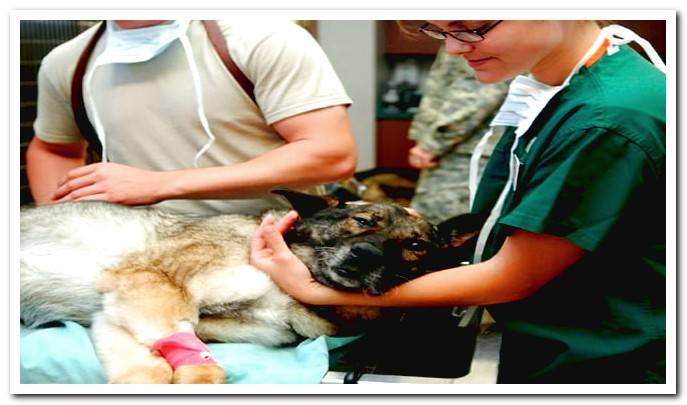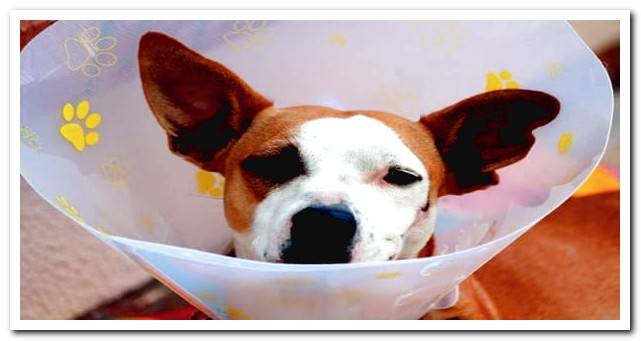
Thanks to advances in veterinary medicine, it is increasingly common for our dogs to undergo surgery. At the same time, they live longer, allowing the development of diseases that may have to be repaired with surgery.
In this article, we will explain what care a dog needs during the postoperative period, to help him feel comfortable and recover better.
Index of contents
- 1 The importance of a quiet environment
- 2 Cleaning the wound
- 3 Medication
- 4 feeding
- 5 When something is wrong
The importance of a quiet environment
When they operate on our dog, it is normal for us to pick him up from the clinic, fully recovered from anesthesia. Depending on the intervention to which he has been subjected, his mobility will be greater or less.
For example, the usual sterilization It does not prevent the dog, just get home, restart your life normally. Instead, operations to resolve fractures may involve the placement of plates, screws, or needles that will reduce movements of the affected leg.
In any case, a recently operated animal you should not make sudden movements no jumps or games during the time indicated by the vet. This will prevent the wound from opening or the operation from failing.
Also, our dog will need a comfortable bed, a good temperature and walks on a leash. In recoveries from trauma surgeries it may be necessary to keep the dog in a room without the possibility of climbing to any height and to reduce walks to a minimum to limit its movements as much as possible.
Cleaning the wound
After surgery, the skin can be closed with sutures or staples. Sometimes the closure is under the skin, so that on the outside we only see the cut. In any case we must watch this wound.
The first days it is normal for it to appear swollen, red or purple, but if the swelling does not subside, some bleeding or purulent discharge occurs, a bad smell, redness in the entire area or pain on palpation, we should immediately notify our vet as an infection could be developing.
Wounds are usually cleaned with a gauze or cotton wool soaked in disinfectant, such as chlorhexidine, once or twice a day, gently, without rubbing (our vet will give us directions).
When the skin is closing it will no longer be necessary to clean it, but we do have to continue observing it until the vet removes the staples or stitches, in the case of these being external. Withdrawal usually occurs between 7-10 days.
Medication
It is common for our veterinaryn to prescribe pain medication, at least for the first few days. You can also give us an antibiotic.
It is important that we respect the administration guidelines and, although the dog seems to be well, we give the complete treatment.
In addition to medication, our vet can give us what is known as Elizabethan necklace, which is a plastic cone that is placed on the neck and, as a lampshade, prevents the dog from reaching the mouth with the wound, since it could infect or open it.
Some dogs are saddened by the Elizabethan on and do not eat. No need to wear it all day, only while we can’t keep an eye on them.

feeding
Unless our dog has undergone surgery that involves the digestive system, in which case the vet will prescribe an adequate diet, during the postoperative period we can give him his usual food.
The first 24-48 hours may not show too much appetite due to discomfort and stress, so we can offer you a more appetizing meal such as homemade or wet food.
After that first moment, he would have to eat normally again. We must also check that he drinks, urinates and defecates as always.
When something is wrong
Although the most common thing is that the postoperative ones pass without any problem and immediately our dog is completely restored, it is true that complications could arise.
Therefore, we must pay attention to the following signs that will indicate that we should seek veterinary attention:
- Incision modifications: As we have said, a swollen, red, painful or smelly wound may be signaling the appearance of an infection, which can also cause fever.
We must immediately notify our vet. In more severe cases, it may be necessary to reopen the wound, place drains and close it, which will complicate the postoperative period.
Other times the inflammation is due to an accumulation of liquids. It receives the name of seroma and we must also communicate it to the vet.
- Anorexy – apathy: If we see that the dog does not want to eat and remains lying down without recovering its normal activity when 24-48 hours have elapsed since the intervention, we must also inform the veterinaryn, as there may be some internal problem even if the wound looks good.
- Mucosal pallor: Nail whitish gums, which can be accompanied by low temperature, that is, we will notice the dog cold to the touch, could be a sign that the dog is suffering from internal bleeding.
It is a situation that requires immediate veterinary assistance since a considerable loss of blood can cause the dog to go into shock, endangering his life.
